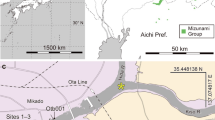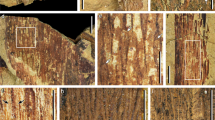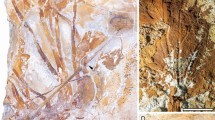Abstract
The evolution of trees of modern size growing together in forests fundamentally changed terrestrial ecosystems1,2,3. The oldest trees are often thought to be of latest Devonian age (about 380–360 Myr old) as indicated by the widespread occurrence of Archaeopteris (Progymnospermopsida)4. Late Middle Devonian fossil tree stumps, rooted and still in life position, discovered in the 1870s from Gilboa, New York5, and later named Eospermatopteris, are widely cited as evidence of the Earth’s ‘oldest forest’6,7. However, their affinities and significance have proved to be elusive because the aerial portion of the plant has been unknown until now. Here we report spectacular specimens from Schoharie County, New York, showing an intact crown belonging to the cladoxylopsid Wattieza (Pseudosporochnales)8 and its attachment to Eospermatopteris trunk and base. This evidence allows the reconstruction of a tall (at least 8 m), tree-fern-like plant with a trunk bearing large branches in longitudinal ranks. The branches were probably abscised as frond-like modules. Lower portions of the trunk show longitudinal carbonaceous strands typical of Eospermatopteris, and a flat bottom with many small anchoring roots. These specimens provide new insight into Earth’s earliest trees and forest ecosystems. The tree-fern-like morphology described here is the oldest example so far of an evolutionarily recurrent arborescent body plan within vascular plants. Given their modular construction, these plants probably produced abundant litter, indicating the potential for significant terrestrial carbon accumulation and a detritus-based arthropod fauna by the Middle Devonian period.
This is a preview of subscription content, access via your institution
Access options
Subscribe to this journal
Receive 51 print issues and online access
$199.00 per year
only $3.90 per issue
Buy this article
- Purchase on Springer Link
- Instant access to full article PDF
Prices may be subject to local taxes which are calculated during checkout



Similar content being viewed by others
References
Algeo, T. J., Scheckler, S. E. & Maynard, J. B. in Plants Invade the Land: Evolutionary and Environmental Approaches (eds Gensel, P. G. & Edwards, D.) 213–236 (Columbia Univ. Press, New York, 2001)
Driese, S. G. & Mora, C. I. in Plants Invade the Land: Evolutionary and Environmental Approaches (eds Gensel, P. G. & Edwards, D.) 237–253 (Columbia Univ. Press, New York, 2001)
Greb, S. F., DiMichele, W. A. & Gastaldo, R. A. in Wetlands Through Time (eds DiMichele, W.A., & Greb, S.) 1–40 (Geol. Soc. Am. Special Paper no. 399, Boulder, Colorado, 2006)
Meyer-Berthaud, B., Scheckler, S. E. & Wendt, J. Archaeopteris is the earliest known modern tree. Nature 938, 700–701 (1999)
Dawson, J. W. On new tree ferns and other fossils from the Devonian. Q. J. Geol. Soc. Lond. 27, 269–275 (1871)
Goldring, W. The oldest known petrified forest. Sci. Mthly 24, 514–529 (1927)
Driese, S., Mora, C. I. & Elick, J. M. Morphology and taphonomy of root and stump casts of the earliest trees (Middle to Late Devonian), Pennsylvania and New York, USA. Palaios 12, 524–537 (1997)
Berry, C. M. A reconsideration of Wattieza Stockmans (here attributed to Cladoxylopsida) based on a new species from the Devonian of Venezuela. Rev. Palaeobot. Palynol. 112, 125–146 (2000)
Goldring, W. The Upper Devonian forest of seed ferns. NY State Mus. Bull. 521, 50–72 (1924)
Kräusel, R. & Weyland, H. Pflanzenreste aus dem Devon IX. Ein Stamm von Eospermatopteris Bau aus dem Mittledevon des Kirberges, Elberfeld. Senckenbergiana 17, 1–20 (1935)
Beck, C. B. Current status of the progymnospermopsida. Rev. Palaeobot. Palynol. 21, 5–23 (1976)
Pigg, K. B. Evolution of Isoetalean lycopsids. Ann. Mo. Bot. Gdn 79, 589–612 (1992)
Boyer, J. S. & Matten, L. C. Anatomy of Eospermatopteris eriana from the Upper Middle Devonian ( = Givetian) of New York. Int. Org. Palaeobot. 5, 13 (1996)
Berry, C. M. & Fairon-Demaret, M. in Plants Invade the Land: Evolutionary and Environmental Approaches (eds Gensel, P. G. & Edwards, D.) 120–158 (Columbia Univ. Press, New York, 2001)
Lemoigne, Y. & Iurina, Y. A. Xenocladia medullosina Ch. A. Arnold (1940) 1952 du Dévonien moyen du Kazakhstan (URSS). Geobios 16, 513–547 (1983)
Stein, W. E. & Hueber, F. M. The anatomy of Pseudosporochnus: P. hueberi from the Devonian of New York. Rev. Palaeobot. Palynol. 60, 311–359 (1989)
Berry, C. M. & Yi, W. A new plant attributed to Cladoxylopsida from the Middle Devonian of Yunnan province, China. Rev. Palaeobot. Palynol. 142, 63–78 (2006)
Soria, A., Meyer-Berthaud, B. & Scheckler, S. E. Reconstructing the architecture and growth habit of Pietschia levis sp. nov. (Cladoxylopsida) from the Late Devonian of southeastern Morocco. Int. J. Plant Sci. 162, 911–926 (2001)
Hilton, J., Geng, B. & Kenrick, P. A novel late Devonian (Frasnian) woody cladoxylopsid from China. Int. J. Plant Sci. 164, 793–805 (2003)
Leclercq, S. & Banks, H. P. Pseudosporochnus nodosus sp. nov., a Middle Devonian plant with cladoxylalean affinities. Palaeontographica B 110, 1–34 (1962)
Berry, C. M. & Fairon-Demaret, M. A reinvestigation of the cladoxylopsid Pseudosporochnus nodosus Leclercq et Banks from the Middle Devonian of Goé, Belgium. Int. J. Plant Sci. 158, 350–372 (1997)
Berry, C. M. & Fairon-Demaret, M. The architecture of Pseudosporochnus nodosus Leclercq et Banks: a Middle Devonian cladoxylopsid from Belgium. Int. J. Plant Sci. 163, 699–713 (2002)
Bridge, J. S. & Willis, B. J. Marine transgressions and regressions recorded in Middle Devonian shore-zone deposits of the Catskill clastic wedge. Geol. Soc. Am. Bull. 106, 1440–1458 (1994)
Banks, H. P., Grierson, J. D. & Bonamo, P. M. in The Catskill Delta (eds Woodrow, D. L. & Sevon, W. D.) 125–141 (Geol. Soc. Am. Special Paper no. 201, Boulder, Colorado, 1985)
Traverse, A. & Schuyler, A. Palynostratigraphy of the Catskill and part of the Chemung magnifacies, southern New York State, USA. Courier Forschungsinstitut Senckenberg 169, 261–274 (1994)
Soria, A. & Meyer-Berthaud, B. Tree fern growth strategy in the late Devonian cladoxylopsid species Pietzschia levis from the study of its stem and root system. Am. J. Bot. 91, 10–23 (2004)
Hammond, S. E. & Berry, C. M. A new species of Tetraxylopteris (Aneurophytales) from the Devonian of Venezuela. Bot. J. Linn. Soc. 148, 275–303 (2005)
Acknowledgements
Financial support was provided by the New York State Museum.
Author Contributions L.V.H. and F.M. were responsible for initial discovery, field work and museum curation, E.L. for geological interpretation, W.E.S. and C.M.B. for palaeobotanical interpretation, F.M. for drawing the reconstruction in Fig. 2, and W.E.S. for writing the paper.
Author information
Authors and Affiliations
Corresponding authors
Ethics declarations
Competing interests
Reprints and permissions information is available at www.nature.com/reprints. The authors declare no competing financial interests.
Supplementary information
Supplementary Information
This file contains Supplementary Discussion and Supplementary Figures S1-S6 with Legends. (PDF 12623 kb)
Rights and permissions
About this article
Cite this article
Stein, W., Mannolini, F., Hernick, L. et al. Giant cladoxylopsid trees resolve the enigma of the Earth’s earliest forest stumps at Gilboa. Nature 446, 904–907 (2007). https://doi.org/10.1038/nature05705
Received:
Accepted:
Issue Date:
DOI: https://doi.org/10.1038/nature05705
This article is cited by
-
Late Devonian (Famennian) phacopid trilobites from western Xinjiang, Northwest China
Palaeobiodiversity and Palaeoenvironments (2023)
-
The impact of vegetation on meandering rivers
Nature Reviews Earth & Environment (2022)
-
Late Devonian (Famennian) phacopid trilobites from western Mongolia
Palaeobiodiversity and Palaeoenvironments (2021)
-
The Hushoot Shiveetiin gol section (Baruunhuurai Terrane, Mongolia): sedimentology and facies from a Late Devonian island arc setting
Palaeobiodiversity and Palaeoenvironments (2021)
-
Advanced vascular function discovered in a widespread moss
Nature Plants (2020)
Comments
By submitting a comment you agree to abide by our Terms and Community Guidelines. If you find something abusive or that does not comply with our terms or guidelines please flag it as inappropriate.



